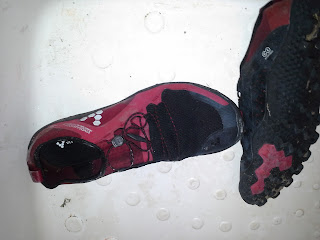Summary
These are proper trail shoes - barefoot shoes for fell runners. They grip like Inov8s but they're zero drop, wide toebox. If you're a barefoot/minimal fell runner, or you have a wide forefoot, or you run in barefoot shoes and you need a proper UK ready shoe that can handle mud, then these have your name on them.
Full Review
 |
| Trail Freak left, PT SG right showing the changed stud density |
Enter the Primus Trail SG. I nearly didn't bother - at 110 GBP they aren't cheap (although I got mine in a 20% promo, 90 quid is still not to be sniffed at), but I thought "Oh well, one more chance, they might have got it right this time".
They have.
These are the running shoes I've been wanting for years. They seem to have been designed by someone who understands off road running. They have the grip of Inov8 roclites, in a zero drop, wide toebox barefoot shoe. The sole is hard enough to give the shoe some structure and protect your feet from stone bruises, but thin enough to still have a minimal feel.
First time out with them was a 20km run in the dark across Rombalds moor. Grip was strong and positive, the forefoot was easily wide enough for my giant duck feet to spread out, and the occasional stone didn't provide a stub hazard as the rands are substantial enough to protect your toes.
Just to check, I went out last night for another try. Full tilt, brakes off from Windgate Nick to Slade above Addingham I didn't slip once. Hill reps up and down the mud and rock of Nab End above Silsden were the same - better than Wave Harriers, about as good as Roclites.
I'm not a total devotee of the 'sport laces' found on most running shoes these days, but I can live with them. The important thing is that I can run confidently on fell terrain, and don't have to buy a new pair every 250km.
Time will tell whether they're more durable than the trail freaks. They certainly feel it, and I'm pretty sure the main problem with trail freaks was that the whole shoe was too flexible, leading to strain on the uppers when contouring. That's certainly not the case with the primus trail SGs, they're much more like fell shoes. I really hope there's enough market to make these popular, because they're exactly what I want out of running shoes.
Updates
Bit chafe-y though
12 month durability update










I run because I’ve never been happier than since I started running. With more encouragement to run as a teenager I’d have had a much healthier, happier time of it.
Now, 6 months into a bout of plantar fasciitis I don’t feel so much like a runner. In a good week I get to do 25-30km at a gentle pace. In a bad one I might get to walk 10km. I can feel the anxiety that dogged me through my teens and early adulthood returning. I can feel the confidence and independence and mental resilience lent me by the ability to run a marathon and more draining away.
I’m still a runner. Somewhere in my head, and my feet, and my heart and lungs, I’m still a runner.
A few more months…
(Cross posted from a comment I made here: https://pursuingthevoid.wordpress.com/2016/07/26/i-cant-run-today-day-2/)